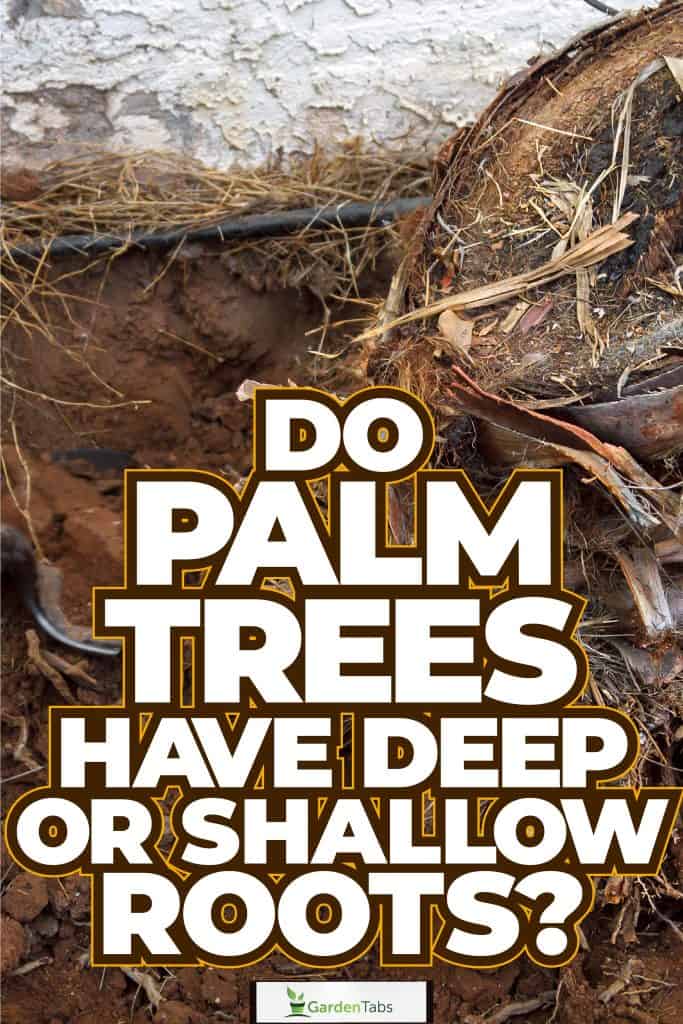Figuring out how the plants in your garden grow isn't always easy. For instance, do you want to plant a palm tree or already have one and are wondering about its root system? How deep are the roots of a palm tree? Are they shallow? We've researched these questions and have answers to share!
The root system of a palm tree typically goes about three feet into the soil. Thin, moderately branching roots grow from the stem.
However, older palm trees may have roots extending 100 feet wide, so they make up for their shallowness with spread.
In this article, we will cover how to grow palm trees and discuss how far their roots extend into the ground. Whether you're new to this tropical species, have a palm tree in your yard, or need other help, you've come to the right post. With that said, let's dive right in!

Do Palm Trees Have Deep Or Shallow Roots?

Palm trees usually have shallow root systems. Most of the time, a palm tree's roots extend around three feet below the ground's surface. However, the spread of your palm's roots may be much greater.
One thing to remember about palm trees is that they feature fibrous root systems. Unlike a taproot extending deep into the ground, a fibrous root system focuses on thin, moderately branching roots growing from the stem.
Your palm tree may even develop a mat-like root system as it matures, making excavation difficult. A drawback to planting palm trees is that they are difficult to dig up, so keep that in mind.
Although shallow-rooted, palm trees can extend far beyond their central root ball. These tropical plants can survive hurricanes, monsoons, and other storms because their roots form an intricate system in the soil.
So, what a palm tree may lack in depth is made up for in width/spread.
How Far Do Palm Tree Roots Extend In The Ground?
When it comes to how far a palm tree's roots extend into the ground, this can be nearly 100 feet. According to the United States Golf Association, palm tree roots can spread easily over 100 feet from the tree's base.
That's one reason you may not see palm trees on golf courses, as they can wreak havoc just under the ground's surface. They're also tough to remove, usually pulling the surrounding soil up with them.
Of course, your palm tree would have to mature to have roots extending 100 feet in either direction, so don't panic if you have a younger, smaller tree. Smaller trees likely won't have such expansive root systems.
Palm trees don't occupy much space above ground, so many people choose to plant them. However, knowing how far their roots may spread throughout their lifetime may be a drawback to some.
Larger, taller palms need structural integrity to withstand winds, rain, and other intense storms.
Luckily, smaller palm tree varieties won't extend more than a few feet in either direction and should have roots less than three feet deep.
Do Palm Trees Have Invasive Roots?

Even though some palm trees will have far-extending root systems, they are not considered invasive. These trees don't usually cause damage to structures like sidewalks, driveways, and home foundations.
Instead, palm tree roots have a gentler approach to growing. Therefore, the other vegetation in your landscape shouldn't have to compete for water, nutrients, or space in the ground.
Palm trees are lovers, not fighters!
However, according to experts, larger palms can cause sidewalk lifting if there's a storm or they become top-heavy.
Like most plants, your palm tree should be planted a few feet from sidewalks, as nature doesn't always respect the idea of pavement.
Large palm tree varieties should be far enough from your home or paved surface to ensure they don't cause issues as they mature.
Do Palm Trees Uproot Easily?
No. Although palm trees typically have shallow roots, they don't uproot easily. One reason for their endurance to weather/age is that their roots extend far beyond the central root ball.
That helps the palm tree to secure itself in the soil. An interesting feature of palm trees is that although they don't extend far into the ground, they can form tightly-knit roots that resemble a mat.
According to Live Science, palm trees are usually one of the last standing trees after a hurricane due to their intricate root development. The thin structure of most palm trees also plays to their advantage during inclement weather.
Your tree can sway and adapt to high winds, unlike a traditional tree that may be thicker toward its base and have a massive canopy.
Wind can swoop under tree canopies, causing them to uproot and blow away. For palm trees, your plant may lose a few palms but should be able to handle just about any conditions.
Many experts consider palm trees ideal for enduring high winds and storms, so if you're in the tropics, this is the ideal tree to grow.
Can You Plant A Palm Tree Near A Pool?

Since palm trees make perfect poolside landscaping, keeping them far enough from the structure is crucial to prevent damage. Generally, you need to leave six or more feet between a pool and a palm tree.
Although your tree may only extend a few feet deep, its width can be problematic. As we covered, older, more enormous palms can have roots extending nearly 100 feet in either direction.
Planting a larger variety of palm tree too close to your swimming pool can result in cracking, root-related damage, and issues with keeping water inside your pool structure.
A common issue pool owners have with palm trees are their roots cracking the pool foundation. Most pools are built with cement, which roots can crack and seep into.
You should consider planting smaller palm trees, like pindo or sabal palms, roughly five or six feet from your swimming pool for best results.
Because of their smaller root systems and sizes, these palms tend to be best for poolside growing and should not cause any damage.
Although having a massive royal palm or one of the other large-growing varieties in the pool area is cool to look at, they'll become a headache over time.
Is A Palm Tree Considered A True Tree?
Yes! Although there have been debates about the legitimacy of palm trees, these plants are mainly considered trees.
Many arborists say that as long as a palm tree has a central stem/trunk and can grow 20 or so feet, it's a real tree.
This is a situation where technicalities come into play. Some people know palm trees as true trees, while others aren't so sure.
Regardless, you should take care of a palm tree as you would any tree species, pruning it each year, giving it plenty of space, and waiting for it to tower over your garden.
It's also worth noting that the American Forests classifies palm trees as trees, as they are woody plants with an erect perennial stem. So, with many plant experts giving them the green light for tree status, we'd have to agree.
How Hard Is It To Dig Up A Palm Tree?

Digging up a palm tree can be incredibly challenging. Besides having a spread up to 100 feet across, your palm tree can also form a mat-like rooting system in the soil.
Because of this dense root formation, excavating a palm tree (especially an older, larger one) can require machinery and professional landscapers.
One of the most difficult parts of the palm tree to dig up is its root ball. Because these trees are shallow-rooted, they depend on their ball to keep them in the soil.
As we mentioned, palm trees are infamous for surviving intense tropical storming, all thanks to their hardy root ball and spread.
Of course, if you can get a company to come out and dig up your palm tree's root ball, the removal process will be much easier.
To Finish Things Up
Whether you have a palm tree growing in your garden or want to plant one, it's always good to know how its root system develops. We found that palm trees typically follow a fibrous root system.
Therefore, your tree will likely extend about three feet deep, with a spread up to 100 feet if the tree is larger and older.
Luckily, palm trees aren't invasive or aggressive, meaning they won't cause damage to structures if they're planted a few feet away.
We also have these garden articles that are worth the read:
Palm Trees That Stay Small [Great Houseplants Options!]




